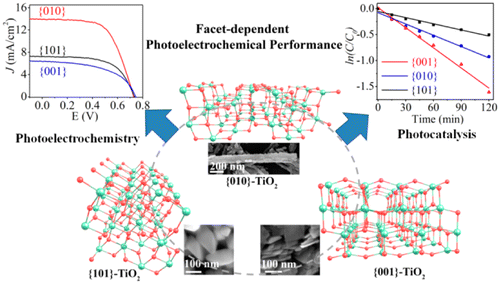The behavior of crystalline nanoparticles depends strongly on which facets are exposed. Some facets are more active than others, but it is difficult to selectively isolate particular facets. This study provides fundamental insights into photocatalytic and photoelectrochemical performance of three types of TiO2 nanoparticles with predominantly exposed {101}, {010}, or {001} facets, where 86–99% of the surface area is the desired facet. Photodegradation of methyl orange reveals that {001}-TiO2 has 1.79 and 3.22 times higher photocatalytic activity than {010} and {101}-TiO2, respectively. This suggests that the photochemical performance is highly correlated with the surface energy and the number of under-coordinated surface atoms. In contrast, the photoelectrochemical performance of the faceted TiO2 nanoparticles sensitized with the commercially available MK-2 dye was highest with {010}-TiO2 which yielded an overall cell efficiency of 6.1%, compared to 3.2% for {101}-TiO2 and 2.6% for {001}-TiO2 prepared under analogous conditions. Measurement of desorption kinetics and accompanying computational modeling suggests a stronger covalent interaction of the dye with the {010} and {101} facets compared with the {001} facet. Time-resolved THz spectroscopy and transient absorption spectroscopy measure faster electron injection dynamics when MK-2 is bound to {010} compared to other facets, consistent with extensive computational simulations which indicate that the {010} facet provides the most efficient and direct pathway for interfacial electron transfer. Our experimental and computational results establish for the first time that photoelectrochemical performance is dependent upon the binding energy of the dye as well as the crystalline structure of the facet, as opposed to surface energy alone.
